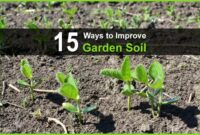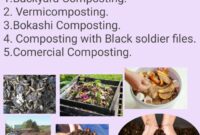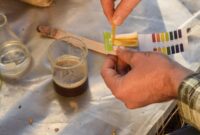How to fix nutrient deficiencies in soil: A crucial guide to maintaining healthy plants by addressing nutrient deficiencies effectively, ensuring optimal growth and vitality. Dive into the world of soil health and discover the secrets to nurturing thriving plant life.
Understanding Nutrient Deficiencies
Soil nutrient deficiencies refer to the lack of essential elements required for plant growth and development. These nutrients include macronutrients such as nitrogen, phosphorus, and potassium, as well as micronutrients like iron, zinc, and magnesium. When plants do not receive an adequate supply of these nutrients, they can exhibit various signs of deficiencies.
Common Signs of Nutrient Deficiencies in Plants
- Yellowing of leaves (chlorosis) due to lack of nitrogen
- Purple or red discoloration of leaves caused by phosphorus deficiency
- Stunted growth and weak stems from insufficient potassium
- Interveinal chlorosis (yellowing between leaf veins) as a sign of iron deficiency
- Poor fruit or flower development resulting from calcium deficiency
Impact of Nutrient Deficiencies on Plant Growth
Nutrient deficiencies can severely impact plant growth and overall health. Without essential nutrients, plants are unable to carry out vital functions such as photosynthesis, nutrient uptake, and hormone production. This can lead to reduced yields, poor fruit quality, and increased susceptibility to pests and diseases. It is crucial to address nutrient deficiencies promptly to ensure optimal plant growth and productivity.
Soil Testing for Nutrient Deficiencies

Soil testing is a crucial step in identifying nutrient deficiencies that may be affecting plant growth. By analyzing the composition of the soil, you can determine which nutrients are lacking and take appropriate measures to address the issue.
If you’re looking for a more advanced gardening method, you might want to consider the difference between hydroponics and soil gardening. While traditional soil gardening is popular and effective, hydroponic systems offer a soil-free alternative that can result in faster plant growth and higher yields. Understanding the pros and cons of each method can help you decide which approach is best for your gardening goals.
Importance of Soil Testing
Soil testing helps in understanding the specific needs of your plants by providing accurate information on nutrient levels. This information allows you to create a customized fertilization plan to optimize plant growth and health.
When it comes to gardening, not everyone has the luxury of a spacious yard. That’s where growing vegetables in containers comes in handy. Whether you have a small balcony or limited outdoor space, container gardening allows you to enjoy fresh produce right at home. With the right soil mix and proper care, you can grow a variety of vegetables like tomatoes, peppers, and herbs in containers.
Methods of Soil Testing
- Chemical Testing: This method involves extracting samples of soil and analyzing them in a lab to determine nutrient levels.
- Physical Testing: Physical characteristics of the soil, such as texture and structure, can also provide insights into nutrient deficiencies.
- Field Testing Kits: These kits provide quick, on-site results that can help in making immediate decisions regarding nutrient deficiencies.
Collecting Soil Samples for Testing
- Use a clean tool to collect samples from various spots in the area you want to test.
- Combine the samples in a clean container, mix thoroughly, and remove any debris.
- Allow the soil to dry before sending it to a testing facility to prevent contamination and ensure accurate results.
Correcting Nutrient Deficiencies

When it comes to correcting nutrient deficiencies in soil, selecting the right fertilizer is crucial for ensuring healthy plant growth and development. This process involves identifying the specific nutrients lacking in the soil and choosing a fertilizer that contains those nutrients in the correct proportions.
Selecting the Right Fertilizer Based on Deficiencies, How to fix nutrient deficiencies in soil
In order to select the right fertilizer to correct nutrient deficiencies, it is important to first conduct a soil test to determine which nutrients are lacking. Once the deficiencies have been identified, you can choose a fertilizer that is specifically formulated to address those deficiencies. For example, if your soil test reveals a nitrogen deficiency, you would choose a fertilizer high in nitrogen content.
Organic vs. Synthetic Fertilizers for Correcting Deficiencies
When it comes to correcting nutrient deficiencies, both organic and synthetic fertilizers can be effective. Organic fertilizers are derived from natural sources and provide a slow release of nutrients to the soil. They can improve soil structure and microbial activity over time. On the other hand, synthetic fertilizers are manufactured and provide a quick release of nutrients to plants. They are often more concentrated and can address deficiencies rapidly.
Techniques for Applying Fertilizers to Address Deficiencies Effectively
To effectively address nutrient deficiencies in soil, it is important to apply fertilizers correctly. This can include methods such as broadcasting the fertilizer evenly over the soil surface, banding the fertilizer in rows where plants will directly benefit, or foliar feeding by spraying the fertilizer directly onto the leaves. It is important to follow the recommended application rates and timings to ensure that the plants receive the nutrients they need to thrive.
Natural Remedies for Soil Nutrient Deficiencies: How To Fix Nutrient Deficiencies In Soil

When dealing with nutrient deficiencies in soil, it is essential to explore natural remedies that can enrich the soil without relying solely on commercial fertilizers. Natural methods not only help improve soil health but also reduce the dependency on synthetic products that can harm the environment in the long run.
Benefits of Using Compost, Manure, or Mulch
Using compost, manure, or mulch is an effective way to replenish nutrients in the soil naturally. These organic materials provide a slow release of essential nutrients, improve soil structure, and enhance microbial activity. Compost and manure also help increase soil organic matter, which is crucial for overall soil health and fertility.
- Compost: Compost is a rich source of organic matter and beneficial microorganisms that can improve soil structure and nutrient availability. It helps retain moisture in the soil and promotes healthy root growth.
- Manure: Animal manure is a valuable source of nitrogen, phosphorus, and potassium, essential nutrients for plant growth. It also contributes to improving soil texture and fertility over time.
- Mulch: Mulching with organic materials like straw, leaves, or grass clippings helps regulate soil temperature, retain moisture, suppress weeds, and gradually release nutrients as it decomposes.
Tips on Crop Rotation and Cover Cropping
Crop rotation and cover cropping are traditional agricultural practices that can help replenish soil nutrients naturally and sustainably. By alternating different crops in a specific sequence, farmers can prevent nutrient depletion and promote soil fertility. Cover cropping involves planting specific crops during fallow periods to protect the soil, fix nitrogen, and add organic matter.
- Crop Rotation: Rotating crops helps break pest and disease cycles, improves soil structure, and balances nutrient levels in the soil. Different crops have varying nutrient requirements, and rotation can help maintain soil health over time.
- Cover Cropping: Cover crops like legumes can fix atmospheric nitrogen into the soil, reducing the need for synthetic nitrogen fertilizers. They also protect the soil from erosion, suppress weeds, and add organic matter when incorporated back into the soil.
In conclusion, mastering the art of fixing nutrient deficiencies in soil is essential for fostering vibrant and flourishing plants. By implementing the strategies discussed, you can create a nutrient-rich environment that supports robust plant growth and overall well-being. Take charge of your soil health and watch your garden thrive!
For those interested in maximizing space and productivity, raised bed gardening is a great option. Raised beds provide better soil drainage, warmer soil temperatures, and fewer weeds compared to traditional garden beds. By following some simple steps to start your raised bed garden, you can create a thriving environment for your plants and enjoy a bountiful harvest.




